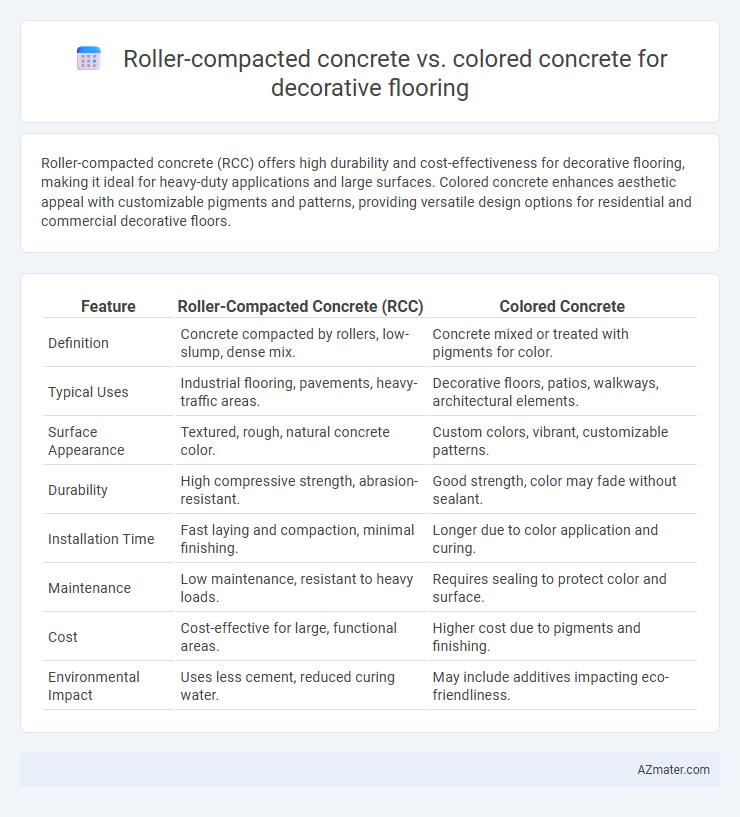Roller-compacted concrete (RCC) offers high durability and cost-effectiveness for decorative flooring, making it ideal for heavy-duty applications and large surfaces. Colored concrete enhances aesthetic appeal with customizable pigments and patterns, providing versatile design options for residential and commercial decorative floors.
Table of Comparison
| Feature | Roller-Compacted Concrete (RCC) | Colored Concrete |
|---|---|---|
| Definition | Concrete compacted by rollers, low-slump, dense mix. | Concrete mixed or treated with pigments for color. |
| Typical Uses | Industrial flooring, pavements, heavy-traffic areas. | Decorative floors, patios, walkways, architectural elements. |
| Surface Appearance | Textured, rough, natural concrete color. | Custom colors, vibrant, customizable patterns. |
| Durability | High compressive strength, abrasion-resistant. | Good strength, color may fade without sealant. |
| Installation Time | Fast laying and compaction, minimal finishing. | Longer due to color application and curing. |
| Maintenance | Low maintenance, resistant to heavy loads. | Requires sealing to protect color and surface. |
| Cost | Cost-effective for large, functional areas. | Higher cost due to pigments and finishing. |
| Environmental Impact | Uses less cement, reduced curing water. | May include additives impacting eco-friendliness. |
Introduction to Decorative Flooring Options
Decorative flooring options include roller-compacted concrete (RCC) and colored concrete, each offering unique aesthetic and functional benefits. Roller-compacted concrete provides high durability and strength with a textured finish suitable for industrial and commercial spaces, while colored concrete allows customization through pigments and staining for vibrant, artistic designs in residential and commercial interiors. Selecting between RCC and colored concrete depends on project requirements such as load capacity, design complexity, and maintenance preferences.
What is Roller-Compacted Concrete?
Roller-compacted concrete (RCC) is a dense, low-slump mixture compacted with heavy rollers, offering high strength and durability for decorative flooring. Unlike traditional colored concrete, RCC requires less water and cement, making it cost-effective and ideal for large surface areas requiring fast installation. Its textured surface can be enhanced with stains or pigments to provide aesthetic appeal while maintaining superior structural performance.
Understanding Colored Concrete
Colored concrete offers versatile options for decorative flooring by integrating pigments directly into the mix, resulting in vibrant and uniform coloration throughout the slab. Unlike roller-compacted concrete, which prioritizes strength and rapid construction for industrial surfaces, colored concrete emphasizes aesthetic appeal with customizable hues and patterns suitable for residential and commercial projects. The durability and UV resistance of pigments in colored concrete enhance long-term visual appeal, making it ideal for decorative applications.
Aesthetic Differences: Texture and Color Variety
Roller-compacted concrete (RCC) offers a rough, textured surface primarily designed for durability and industrial applications, providing limited color variety mostly through integral pigments. Colored concrete, on the other hand, delivers a smoother finish with extensive color options, including stains, dyes, and overlays, enhancing the visual appeal for decorative flooring. The aesthetic differences stem from RCC's coarse, matte texture versus colored concrete's customizable, vibrant appearance suitable for intricate design patterns.
Installation Process Comparison
Roller-compacted concrete (RCC) installation involves spreading a dry concrete mix with minimal water using heavy rollers for compaction, resulting in a dense, durable surface suitable for industrial and high-traffic decorative flooring. Colored concrete requires precise mixing of pigments with the concrete batch, followed by meticulous placement, finishing, and often sealing to ensure consistent color and enhanced aesthetic appeal, making the process more labor-intensive and time-sensitive than RCC. The RCC method offers faster installation and curing times, while colored concrete demands more careful handling to maintain uniform color and texture throughout the decorative flooring.
Durability and Maintenance
Roller-compacted concrete (RCC) offers exceptional durability due to its dense, low-slump composition, making it highly resistant to heavy traffic and abrasion, which reduces long-term maintenance needs. Colored concrete, while providing aesthetic versatility through integral pigments or surface treatments, can be more susceptible to fading, staining, and wear, requiring periodic sealing and upkeep to maintain its appearance. Choosing RCC for decorative flooring ensures a robust surface with minimal maintenance, whereas colored concrete demands more frequent care to preserve its vibrant look.
Cost Analysis: Initial and Long-Term Expenses
Roller-compacted concrete (RCC) offers lower initial costs compared to colored concrete due to minimal finishing requirements and faster installation, reducing labor expenses. Colored concrete typically incurs higher upfront costs from pigments, specialized labor, and surface treatments necessary to achieve aesthetic appeal. Over the long term, RCC generally demands less maintenance and repair, translating into lower lifecycle costs, while colored concrete may require periodic resealing and color restoration to preserve its decorative look, increasing ongoing expenses.
Best Applications for Each Concrete Type
Roller-compacted concrete (RCC) is ideal for heavy-duty decorative flooring in industrial settings, parking lots, and warehouses due to its high compressive strength and rapid construction time. Colored concrete excels in residential patios, walkways, and architectural features where aesthetic appeal and customization with pigments or stains are paramount. Choosing between RCC and colored concrete depends on the balance of durability requirements and desired visual effects for specific flooring applications.
Environmental Impact and Sustainability
Roller-compacted concrete (RCC) offers significant environmental advantages over colored concrete due to its lower cement content and reduced water usage, which minimize carbon emissions and resource consumption during production. Colored concrete, while aesthetically versatile, often relies on synthetic pigments and additional processing that can increase its environmental footprint and chemical runoff risk. RCC's durability and reduced maintenance needs further enhance its sustainability by extending flooring lifespan and lowering long-term resource demand.
Choosing the Right Decorative Concrete for Your Project
Selecting the right decorative concrete involves evaluating the finish, durability, and aesthetic appeal required for your project. Roller-compacted concrete offers high strength and cost-efficiency ideal for industrial or large-scale flooring, while colored concrete provides vibrant hues and design flexibility suitable for residential and commercial decorative surfaces. Understanding project-specific needs such as traffic load, weather exposure, and design complexity ensures the optimal choice between roller-compacted and colored concrete for long-lasting, visually appealing flooring.

Infographic: Roller-compacted concrete vs Colored concrete for Decorative flooring
 azmater.com
azmater.com